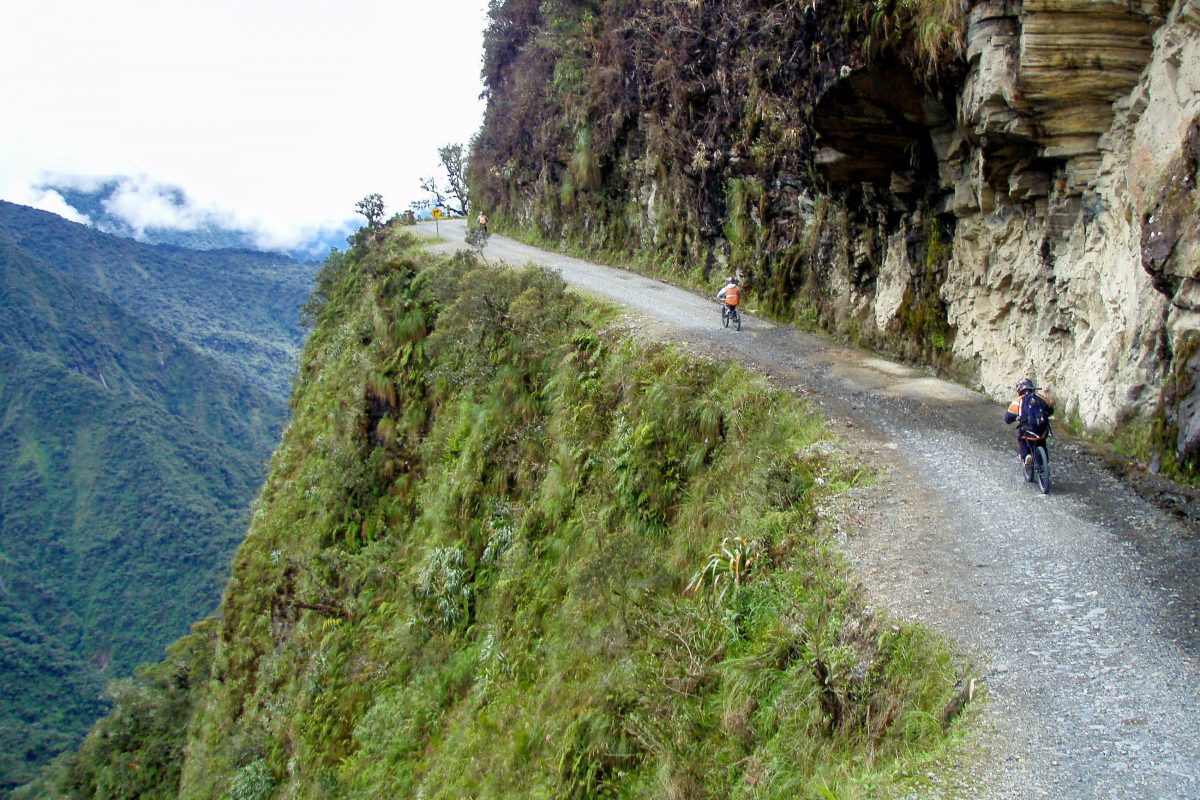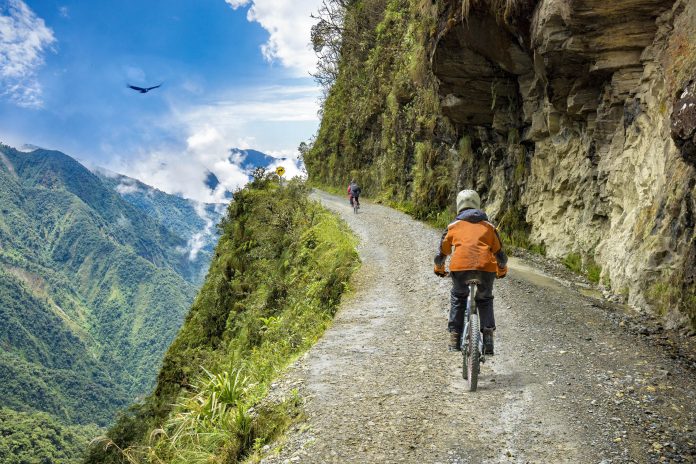Als offiziell gefährlichste Straße der Welt führt die „Todesstraße“ von La Paz bis in die Yungas-Täler ohne Leitplanken an den nahezu senkrecht abfallenden Bergflanken der Cordillera Real entlang.
Die Yungas-Straße im Westen von Bolivien führt durch die dicht bewachsenen Hänge der Cordillera Real. Entlang steiler Bergflanken windet sich die einspurige Straße von La Paz bis nach Coroico in den Yungas-Tälern.
Sie gilt als gefährlichste Straße der Welt und wird auch als „Die Todesstraße“ (El Camino de la Muerte) bezeichnet. Auf einer Strecke von rund 65 Kilometern überwindet sie 3450 Höhenmeter und durchläuft vom kalten, trockenen Altiplano bei La Paz bis in den feucht-warmen Regenwald fast alle Klimazonen Südamerikas.
Inhaltsverzeichnis
BILDER: El Camino de la Muerte (Todesstraße)
Fotogalerie: El Camino de la Muerte (Todesstraße)
Entstehung der Todesstraße

Erbaut wurde die Yungas-Straße von paraguayischen Gefangenen des Chaco-Krieges. Am „Balconsillo“, wo der mit 700 Metern längste freie Fall entlang der Straße liegt, wurden die Unglücklichen damals handgefesselt in den Abgrund geführt, nachdem sie die Straße fertig gemeißelt hatten. An dieses grausame Schicksal erinnert heute ein Gedenkstein.
Damals war die Todesstraße eine der wenigen und damit bedeutende Verbindung zwischen Boliviens Amazonas-Regenwald und dem Regierungssitz La Paz. Der höchste Punkt der Strecke ist der La Cumbre Pass auf 4.650 Metern, der tiefste liegt bei Yolosa kurz vor Coroico auf 1.200 Metern Seehöhe.
Die Yungas-Straße wurde in den 1930ern fertiggestellt und erhielt bald nach ihrer Entstehung den Ruf als weltweit gefährlichste Straße. 1995 wurde sie von der Interamerikanischen Entwicklungsbank auch offiziell so bezeichnet.
Gefährlichste Straße der Welt

Die auf der engen Straße allgegenwärtigen steilen Abhänge sind nirgends durch Leitplanken gesichert und jeden Moment können Erdrutsche oder Steine auf die Reisenden niedergehen. Die einspurige Straße, auf der bis 2006 viel Verkehr herrschte, ist außerdem nicht befestigt und verwandelt sich bei Niederschlag in eine matschige Rutschbahn. Beeinträchtigt dann vielleicht auch noch Nebel die Sicht, wird die Fahrt auf der Todesstraße tatsächlich zu einem waghalsigen Unterfangen.
Kein Wunder, dass sich der schlimmste bekannte Verkehrsunfall Boliviens auf genau dieser Straße ereignete. Dabei stürzte am 24. Juli 1983 ein Bus mit rund 100 Passagieren in den Abgrund. Unzählige Kreuze am Straßenrand erinnern an diverse andere Unglücksstellen. Schätzungen zufolge forderte die Camino de la Muerte bis 2007 jedes Jahr an die 300 Opfer.
Unterwegs auf der Todesstraße

2006 wurde eine zwar längere, dafür aber gut ausgebaute und um einiges weniger riskante Umfahrungsstraße von La Paz in die Yungas-Täler eröffnet. Der LKW-Verkehr, der maßgeblich zur Gefährlichkeit der Yungas-Straße beitrug, wurde nun gänzlich auf diese Ausweich-Route verlegt. Seitdem sind auf der Camino de la Muerte hauptsächlich Touristen und wagemutige Downhill-Mountainbiker anzutreffen, die dem Nervenkitzel nicht widerstehen können.
Die Gefährlichkeit der Camino de la Muerte ist um einiges gesunken, eine Fahrt auf ihr gestaltet sich aber dennoch als äußerst spektakulär. Mehrere Aussichtspunkte in den Kurven geben Einblicke in die schaurige Schlucht, in die früher jeden Monat durchschnittlich 2 Fahrzeuge stürzten. Nach wie vor herrscht auf der Yungas-Straße ausnahmsweise Linksverkehr, damit bei Ausweichmanövern der Straßenrand besser abgeschätzt werden kann.
Zweite Todesstraße nach Chulumani
Neben der nördlichen Yungas-Straße führt auch eine zweite, südlicher gelegene Yungas-Straße von La Paz ins 64km entfernte Chulumani. Die Strecke Richtung Osten ist zwar weniger bekannt, aber nahezu ebenso gefährlich wie die „offizielle“ Todesstraße.





